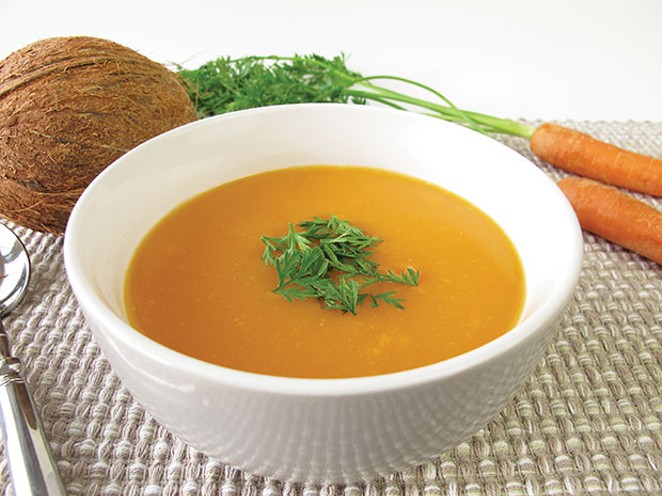Turmeric is a spice rack regular in my kitchen. I use the deep orange powder when cooking Indian or Southeast Asian cuisine, and usually throw a pinch in when I’m making deviled eggs for more vividly colored yolks. It was never a spice that I gave much consideration though: often it is used as part of a spice blend in spicy, complex curry dishes. On its own it seemed rather innocuous, even mild in comparison to the heady aromas of cardamom and cumin that it is so often mixed with. Sometimes referred to as “poor man’s saffron,” it is often used to mimic the hue of the costly crocus threads, and is mild enough not to overwhelm the dish. Cut into a piece of fresh turmeric however, and the fresh, musky aroma is startling in its assertiveness.
Turmeric is native to India and has been used for over 4,000 years in Ayurvedic and Chinese medicine to treat digestive problems, skin diseases, liver disease and in topical ointments. According to the University of Maryland Medical Center, curcumin, the powerful antioxidant responsible for turmeric’s vivid hue, lowers the levels of enzymes in the body that cause inflammation and helps to prevent platelets from clumping together to form blood clots. Studies suggest that curcumin may be useful in developing treatments for Alzheimer’s disease, and correlations have been made between populations of people who consume higher quantities of turmeric and lower incidences of Alzheimer’s disease. Black pepper gets its bite from piperine, an alkaloid that augments the absorption and anti-inflammatory effects of turmeric, and so the two spices are often used together.
Turmeric was likely first used as a dye and, be warned, the deep orange-colored root will stain hands and cuticles, cutting boards and countertops. Wear food service gloves to prevent staining your fingers. Whiten plastic cutting boards by soaking in a bleach solution. For stained countertops or clothing, make a paste of baking soda and allow it to dry on the stain before rinsing.
Fresh turmeric has become more widely available thanks to increasing interest in its health benefits. I’d noticed it sitting next to the ginger at the grocery store, and having only ever used turmeric in the dried powdered form, I threw a couple pieces into my shopping cart to experiment with. I’ve since fallen in love with its warm, spicy aroma and the bright sunny character it adds to everything from soups to pilafs.
Turmeric is a member of the ginger family and is stored and prepared in a very similar fashion. Look for firm, unblemished pieces, then wrap them in a paper towel and store them in a plastic bag in the refrigerator. When ready to use, cut off the knobby ends and peel with a vegetable peeler or the back of a spoon. Grated turmeric can be added to rice or lentil dishes, soups, stews or even scrambled eggs. Slices of peeled turmeric, ginger and lemon steeped in hot water make a delicious tummy-soothing tea.
After all these years it’s wonderful to meet an old ingredient again and to learn to use it in a whole new way.
Spiced Golden Milk
• 2 cups milk of choice
• 1 tablespoon each grated turmeric and ginger
• 1-inch piece of cinnamon stick
• 2 whole cloves
• 1 cardamom pod
• 2 teaspoons whole black peppercorns
• Honey, to taste
Combine all ingredients in a medium saucepan. Bring to a simmer over medium heat and continue to simmer, covered, for 10 minutes. Strain through a cheesecloth or coffee filter, sweeten to taste and enjoy!
Carrot and Coconut Soup
• 1 pound carrots, preferably organic
• 1 onion, diced
• 1 tablespoon coconut oil
• 1 tablespoon freshly grated turmeric
• 4 cups chicken stock, low-sodium or homemade
• 1 can coconut milk
• Freshly ground black pepper and kosher salt
• Unsweetened yogurt, to serve
• Chopped mint and parsley, to serve
Wash and scrub carrots well, then cut them into 1-inch pieces. In a 3-qt. saucepan, sauté onion in oil until soft and just beginning to brown, about 3-4 minutes. Add turmeric and stir briefly, then add carrots, chicken stock, coconut milk. Season to taste with salt and pepper, and then bring the pot to a boil. Reduce to a simmer, then continue to cook for 20 minutes, or until carrots are soft. Remove from the heat; allow to cool slightly, then puree in a blender until smooth. ALWAYS use caution when blending hot liquids (pressure can build up from the steam and cause the top of the blender to blow!). Return the pureed soup to the saucepan and rewarm over medium heat. Ladle into bowls and garnish with yogurt and herbs.
Contact Ashley Meyer at [email protected].



















